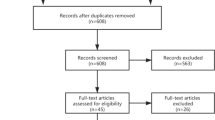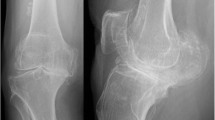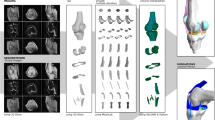Abstract
Purpose
This study aims to evaluate whether different tibial–femoral conformities for patient-specific mobile-bearing unicompartmental knee arthroplasties (UKAs) preserve natural knee kinematics, using computational simulations.
Methods
Different designs for patient-specific mobile-bearing UKAs were evaluated using finite element analysis. Three designs for the identical femoral component were considered: flat (non-conforming design), anatomy-mimetic, and conforming for the tibial insert.
Results
The conforming design for the patient-specific mobile-bearing UKAs exhibited a 1.2 mm and 0.7° decrease in the translation and rotation, respectively, in the swing phase compared with those of the natural knee. In addition, the femoral rollback and internal rotation were 2.6 mm and 1.2° lower, respectively, than those of the natural knee, for the conforming design under the deep-knee-bend condition. The flat design for the patient-specific mobile-bearing UKAs exhibited a 2.2 mm and 1.4° increase in the femoral rollback and rotation compared with the natural knee under the deep-knee-bend condition. The anatomy-mimetic patient-specific mobile-bearing UKAs best preserved the natural knee kinematics under the gait and deep-knee-bend loading conditions.
Conclusions
The kinematics of the loading conditions in patient-specific mobile-bearing UKAs was determined to closely resemble those of a native knee. In additional, by replacing the anatomy-mimetic design with a mobile-bearing, natural knee kinematics during gait and deep-knee-bend motions is preserved. These results confirm the importance of tibiofemoral conformity in preserving native knee kinematics in patient-specific mobile-bearing UKA.




Similar content being viewed by others
References
Berger RA, Meneghini RM, Jacobs JJ, Sheinkop MB, Della Valle CJ, Rosenberg AG, Galante JO (2005) Results of unicompartmental knee arthroplasty at a minimum of 10 years of follow-up. J Bone Joint Surg Am 87:999–1006
Blankevoort L, Huiskes R (1996) Validation of a three-dimensional model of the knee. J Biomech 29:955–961
Carpenter DP, Holmberg RR, Quartulli MJ, Barnes CL (2014) Tibial plateau coverage in UKA: a comparison of patient specific and off-the-shelf implants. J Arthroplasty 29:1694–1698
Catani F, Benedetti MG, Bianchi L, Marchionni V, Giannini S, Leardini A (2012) Muscle activity around the knee and gait performance in unicompartmental knee arthroplasty patients: a comparative study on fixed- and mobile-bearing designs. Knee Surg Sports Traumatol Arthrosc 20:1042–1048
Fitz W (2009) Unicompartmental knee arthroplasty with use of novel patient-specific resurfacing implants and personalized jigs. J Bone Joint Surg Am 91(Suppl 1):69–76
Fox AJ, Bedi A, Rodeo SA (2012) The basic science of human knee menisci: structure, composition, and function. Sports Health 4:340–351
Freeman MA, Pinskerova V (2005) The movement of the normal tibio-femoral joint. J Biomech 38:197–208
Furnes O, Espehaug B, Lie SA, Vollset SE, Engesaeter LB, Havelin LI (2007) Failure mechanisms after unicompartmental and tricompartmental primary knee replacement with cement. J Bone Joint Surg Am 89:519–525
Gleeson RE, Evans R, Ackroyd CE, Webb J, Newman JH (2004) Fixed or mobile bearing unicompartmental knee replacement? A comparative cohort study. Knee 11:379–384
Godest AC, Beaugonin M, Haug E, Taylor M, Gregson PJ (2002) Simulation of a knee joint replacement during a gait cycle using explicit finite element analysis. J Biomech 35:267–275
Grood ES, Suntay WJ (1983) A joint coordinate system for the clinical description of three-dimensional motions: application to the knee. J Biomech Eng 105:136–144
Halloran JP, Clary CW, Maletsky LP, Taylor M, Petrella AJ, Rullkoetter PJ (2010) Verification of predicted knee replacement kinematics during simulated gait in the Kansas knee simulator. J Biomech Eng 132:081010
Hamilton TW, Rizkalla JM, Kontochristos L, Marks BE, Mellon SJ, Dodd CAF, Pandit HG, Murray DW (2017) The interaction of caseload and usage in determining outcomes of unicompartmental knee arthroplasty: a meta-analysis. J Arthroplasty 32:3228–3237.e3222
Heyse TJ, El-Zayat BF, De Corte R, Chevalier Y, Scheys L, Innocenti B, Fuchs-Winkelmann S, Labey L (2014) UKA closely preserves natural knee kinematics in vitro. Knee Surg Sports Traumatol Arthrosc 22:1902–1910
Hopkins AR, New AM, Rodriguez-y-Baena F, Taylor M (2010) Finite element analysis of unicompartmental knee arthroplasty. Med Eng Phys 32:14–21
Inoue S, Akagi M, Asada S, Mori S, Zaima H, Hashida M (2016) The valgus inclination of the tibial component increases the risk of medial tibial condylar fractures in unicompartmental knee arthroplasty. J Arthroplasty 31:2025–2030
Kang KT, Kim SH, Son J, Lee YH, Chun HJ (2016) Computational model-based probabilistic analysis of in vivo material properties for ligament stiffness using the laxity test and computed tomography. J Mater Sci Mater Med 27:183
Kang KT, Koh YG, Son J, Kim SJ, Choi S, Jung M, Kim SH (2017) Finite element analysis of the biomechanical effects of 3 posterolateral corner reconstruction techniques for the knee joint. J Arthroscopy 33:1537–1550
Kang KT, Koh YG, Son J, Kwon OR, Park KK (2018) Flexed femoral component improves kinematics and biomechanical effect in posterior stabilized total knee arthroplasty. Knee Surg Sports Traumatol Arthrosc 27:1174–1181
Kang KT, Kwon SK, Son J, Kwon OR, Lee JS, Koh YG (2018) The increase in posterior tibial slope provides a positive biomechanical effect in posterior-stabilized total knee arthroplasty. Knee Surg Sports Traumatol Arthrosc 26:3188–3195
Kang KT, Son J, Suh DS, Kwon SK, Kwon OR, Koh YG (2018) Patient-specific medial unicompartmental knee arthroplasty has a greater protective effect on articular cartilage in the lateral compartment: a finite element analysis. Bone Joint Res 7:20–27
Koeck FX, Beckmann J, Luring C, Rath B, Grifka J, Basad E (2011) Evaluation of implant position and knee alignment after patient-specific unicompartmental knee arthroplasty. Knee 18:294–299
Koh YG, Son J, Kwon OR, Kwon SK, Kang KT (2018) Patient-specific design for articular surface conformity to preserve normal knee mechanics in posterior stabilized total knee arthroplasty. Biomed Mater Eng 29:401–414
Koh YG, Son J, Kwon OR, Kwon SK, Kang KT (2018) Tibiofemoral conformity variation offers changed kinematics and wear performance of customized posterior-stabilized total knee arthroplasty. Knee Surg Sports Traumatol Arthrosc 27:1213–1223
Koh YG, Son J, Kwon SK, Kim HJ, Kwon OR, Kang KT (2017) Preservation of kinematics with posterior cruciate-, bicruciate- and patient-specific bicruciate-retaining prostheses in total knee arthroplasty by using computational simulation with normal knee model. Bone Joint Res 6:557–565
Kutzner I, Heinlein B, Graichen F, Bender A, Rohlmann A, Halder A, Beier A, Bergmann G (2010) Loading of the knee joint during activities of daily living measured in vivo in five subjects. J Biomech 43:2164–2173
Kwon OR, Kang KT, Son J, Kwon SK, Jo SB, Suh DS, Choi YJ, Kim HJ, Koh YG (2014) Biomechanical comparison of fixed- and mobile-bearing for unicomparmental knee arthroplasty using finite element analysis. J Orthop Res 32:338–345
Liddle AD, Pandit H, Judge A, Murray DW (2015) Patient-reported outcomes after total and unicompartmental knee arthroplasty: a study of 14,076 matched patients from the National Joint Registry for England and Wales. Bone Joint J 97-b:793–801
Mochizuki T, Sato T, Blaha JD, Tanifuji O, Kobayashi K, Yamagiwa H, Watanabe S, Matsueda M, Koga Y, Omori G, Endo N (2014) Kinematics of the knee after unicompartmental arthroplasty is not the same as normal and is similar to the kinematics of the knee with osteoarthritis. Knee Surg Sports Traumatol Arthrosc 22:1911–1917
Mochizuki T, Sato T, Tanifuji O, Kobayashi K, Koga Y, Yamagiwa H, Omori G, Endo N (2013) In vivo pre- and postoperative three-dimensional knee kinematics in unicompartmental knee arthroplasty. J Orthop Sci 18:54–60
Peersman G, Slane J, Vuylsteke P, Fuchs-Winkelmann S, Dworschak P, Heyse T, Scheys L (2017) Kinematics of mobile-bearing unicompartmental knee arthroplasty compared to native: results from an in vitro study. Arch Orthop Trauma Surg 137:1557–1563
Pena E, Calvo B, Martinez MA, Palanca D, Doblare M (2006) Why lateral meniscectomy is more dangerous than medial meniscectomy. A finite element study. J Orthop Res Off Publ Orthop Res Soc 24:1001–1010
Smith TO, Hing CB, Davies L, Donell ST (2009) Fixed versus mobile bearing unicompartmental knee replacement: a meta-analysis. Orthop Traumatol Surg Res 95:599–605
Steklov N, Slamin J, Srivastav S, D’Lima D (2010) Unicompartmental knee resurfacing: enlarged tibio-femoral contact area and reduced contact stress using novel patient-derived geometries. Open Biomed Eng J 4:85–92
Van Den Heever DJ, Scheffer C, Erasmus PJ, Dillon EM (2010) Contact stresses in a patient-specific unicompartmental knee replacement. Conf Proc IEEE Eng Med Biol Soc 2010:5113–5116
Varadarajan KM, Zumbrunn T, Rubash HE, Malchau H, Li G, Muratoglu OK (2015) Cruciate retaining implant with biomimetic articular surface to reproduce activity dependent kinematics of the normal knee. J Arthroplasty 30:2149–2153.e2142
Walker T, Heinemann P, Bruckner T, Streit MR, Kinkel S, Gotterbarm T (2017) The influence of different sets of surgical instrumentation in Oxford UKA on bearing size and component position. Arch Orthop Trauma Surg 137:895–902
Wiik AV, Aqil A, Tankard S, Amis AA, Cobb JP (2015) Downhill walking gait pattern discriminates between types of knee arthroplasty: improved physiological knee functionality in UKA versus TKA. Knee Surg Sports Traumatol Arthrosc 23:1748–1755
Funding
There is no funding source.
Author information
Authors and Affiliations
Corresponding author
Ethics declarations
Conflict of interest
The authors declare that they have no conflict of interest.
Ethical approval
Approval was not required, as neither human participants nor animals were involved in this study.
Additional information
Publisher's Note
Springer Nature remains neutral with regard to jurisdictional claims in published maps and institutional affiliations.
Rights and permissions
About this article
Cite this article
Koh, YG., Lee, JA., Lee, HY. et al. Anatomy-mimetic design preserves natural kinematics of knee joint in patient-specific mobile-bearing unicompartmental knee arthroplasty. Knee Surg Sports Traumatol Arthrosc 28, 1465–1472 (2020). https://doi.org/10.1007/s00167-019-05540-0
Received:
Accepted:
Published:
Issue Date:
DOI: https://doi.org/10.1007/s00167-019-05540-0




